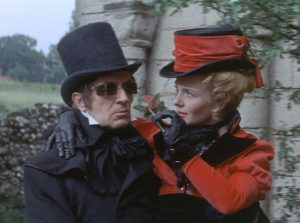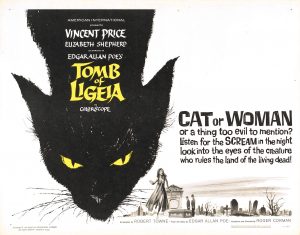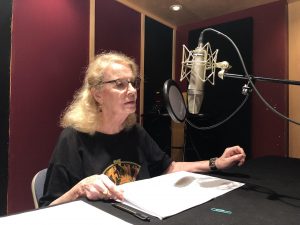‘Ligeia’: Elizabeth Shepherd on Poe, Price, Corman, New CD
Baltimore — Edgar Allan Poe would be very proud of Elizabeth Shepherd. In a twist of fate only the master storyteller might have imagined, the beautiful British actress saw her brief turn as the original Mrs. Peel in The Avengers go up in smoke, only to rise from the ashes with a theatrical vengeance in Roger Corman’s cult classic The Tomb of Ligeia.
We caught up with Shepherd last month at the 2019 Mid-Atlantic Nostalgia Convention, where she gave a stellar reading from her new CD of the Poe short story Ligeia. Shepherd’s recording of Edgar Allan Poe’s Ligeia: A Tale of Mystery and Imagination is available on GooglePlay, Audible, and other fine audio platforms.
BPE: Before we begin, I must tell you I was in the audience last night and how thoroughly enjoyable your reading of Ligeia was. I can’t help but say I detected a bit of Joan Greenwood in your voice.
ES: Well, in this instance I consider that to be a huge compliment.
BPE: How did this new recording of Ligeia come to be?

ES: Well, of course, my film – The Tomb of Ligeia – is based on this wonderful Edgar Allan Poe story. A tale of mystery and imagination! It was that atmosphere that Roger Corman was intent on putting into all of his Poe films. He didn’t consider them to be horror films. They were gothic stories.
When I knew I was going to be in the film, I read the story, and I’ve loved it ever since. Of course, the film script actually develops the story in slightly different ways. In any case, as I was traveling with Matt Beckoff to different nostalgia conventions, I would read the story, or at least a truncated version of it. Some years ago, he said, “You should record the whole story.” So finally we’ve done it!
It’s the whole story of Ligeia, plus several poems of Edgar Allan Poe, including, of course, the famous Annabel Lee. And there are some poems he wrote to his cousin Elizabeth – most appropriately. So this is the launch and we’re very excited about it going out to the world.
BPE: How does this new recording compare to your previous readings of Ligeia?
ES: Well, as I said, I’d done other readings before, but this is the first since I recorded the whole story on a CD. It’s really complex. These days, to hear such beautiful language come to life is really important. We’re losing vocabulary in our society; we’re losing language. And so, the more beautiful language of Poe and Shakespeare you can send out into the world, the better.
BPE: Before we get into the recording of the CD, would you talk a bit about working with Roger Corman and Vincent Price?

ES: Two very, very classy guys. I made the film in 1964, before I emigrated and didn’t know about Corman and the whole series of Poe films. I just knew Vincent Price from Laura, so this was a whole new world for me.
Working with Vincent – what a brilliant actor! He kind of spoofed the genre later. I think at times his great sense of humor caused people to underestimate him as a classical actor. He was just wonderful to work with.
Robert Towne had given us a good script, where there was really something for us to play. I think the emotional stakes in this film are deeper than in any of the others, which is why this particular film – the last of the series – was the film both Vincent and Roger said was their favorite.
But Vincent – what a lovely person. And so accomplished in so many, many ways.
I don’t think anybody ever had a bad word to say about Vincent Price.
BPE: And Roger Corman?
ES: Oh, yes, Roger Corman – what he did! He always knew exactly what he wanted. And he surrounded himself with people who were efficient professionals.
Of course, Roger was known to make films in a few days. The Tomb of Ligeia was an epic five whole weeks that we had and one week on location in Norfolk.
Visually, that opened the film up.
This beautiful ruin – Castle Acre Priory – became our abbey in the film. Using the priory makes the film visually spectacular.
BPE: What was it like working for Roger Corman?

ES: In order for him to work with actors, he wanted to understand them, so Roger went to the Actors Studio to study; to find out what our process was. Which was extremely wise of him.
What he would do was talk at great length with you before filming. That way, we were on exactly the same wavelength as to what we were aiming at with the character, so we didn’t waste time on the set. Once he had talked to me and Vincent and the other leading actors, then he entrusted the roles to us.
Vincent and I would rehearse together, and the fact that we both came from a theatre background, we were thrilled to be joined by the cream of English character actors. For the opening shot – the mesmerism scene – we played the whole thing like it was a play. We could do that because we were all theatre actors. We could take a scene and really knew how to play it.
Roger then would be free to tell the story visually. His eye for composition was really brilliant. The way he wove color to make the look of the film opulent. Again, Roger Corman – although he made a lot of what was called schlock – the amount of energy he put into American cinema with his own work. And the way he gave opportunities to Scorsese and Coppola and Jack Nicholson, along with many others, plus bringing foreign films into the American repertoire. He may be known as the “King of the B’s,” but as far as I’m concerned, he is King of the Whole Alphabet.
BPE: You were stage-trained in Britain. Did you do radio over there?
ES: No, though I did quite a bit of recording in Canada for CBC radio. This (Ligeia) is a spoken word CD, and I would like to do more of that, I must say. Of all the different mediums, radio was the least in my repertoire.
BPE: It’s a different kind of medium?
ES: In a way, yes, because you have to bring the words off the page. I think of that old expression, “Oh, I can hear it in her voice.” That is what is required for radio. You must be able to hear it in my voice.

BPE: Could you talk about the similarities and/or differences between preparing for stage or film role versus doing a dramatic reading?
ES: I think that the creation of character is absolutely the same. You’ll go into depth in creating the character – almost as if doing it in 3D.
As I was preparing for reading Ligeia, I had to study the language – which is quite complex. In one long sentence, there may be several different phases. You have to follow the sense through so that you don’t lose track of it. This means you have to be very open to everything that (the narrator) is thinking and feeling and all the different complexities. And although that narrator in the story is, in fact, the man, he is talking about Ligeia. Having played Ligeia, I am able to somehow bring in the feeling of who she is.
He describes her visually and in her personality and with her emotional depth. But also, he very much describes her voice – this low voice. So that gives me a clue as to how to present her.
When he begins to dramatize her, I enter into the drama of it.
BPE: Didn’t the film take liberties with the story for dramatic sake?
ES: Yes! In Poe’s story, it’s all about Ligeia. She stars in the story. After she dies, her husband becomes an opium addict. And although he marries Rowena – his second wife – she is like a cypher. There is no love lost between the pair. In his opium-fueled dreams, he is always thinking about Ligeia.

When Rowena falls sick and dies, it is implicated that it is somehow Ligeia’s spirit that is willing this to happen. So, Rowena’s dead body becomes a vehicle for Ligeia’s return. The final revelation at the end is the man has become completely addicted, so whether or not what he has imagined is true, it certainly is real for him.
All of this happens in an opium dream. So, when I read the original Poe story and then read the script, I was rather indignant on behalf of Ligeia. She was now in the background to the second wife Rowena – who is more a creation of Robert Towne. When I pointed this out, Roger Corman said, “Ah, but Elizabeth – an opium dream is not very cinematic.”
So, he and Robert Towne very clearly substituted mesmerism, which was very fashionable. The hypnotic trance is a substitute for the opium. Ligeia – before she died – put her husband under a hypnotic spell, so that she can keep hold of him. Even though she is dead, he will come and visit her every night.
In the end, it’s a love story about two wives: One whose love is possessive and one whose love is redemptive. It’s still within the spirit of Poe.
There is one other character who is introduced in the film: the Black Cat. The cat is almost the agent in the way that a witch has a familiar. In the final scenes, Vincent’s character realizes he must get rid of the cat. Then, of course, everything burns down. Vincent Price once said, “I always get singed in a Roger Corman movie.”
And indeed, in the final scene – where the dead bodies of Ligeia and her husband are lying together – the whole set was covered with that flammable jell stuff. It caught alight before the action! We felt this flame licking at our feet, and Vincent grabbed me to pull me out of there. The fire had to be put out and the whole set needed to be redressed. Roger was not a bit pleased about that. But the whole affair was quite exciting – nearly getting burnt alive!
BPE: As exciting as riding a horse?
ES: Oh, my, I am NOT a horsewoman, but Rowena certainly was, so I had to learn to ride side-saddle for the film. I don’t know if you’ve ever seen a side-saddle, but the way they are designed, you can hook both legs to be safe. I actually felt safer on the side-saddle than riding astride.
They had three horses that looked alike. One that did the hunt; one that was a spirited horse; and one that was a very boring horse that I was to sit on after my double rode the spirited horse into the shot. I took one look at this boring horse, and I said, “The Lady Rowena would not be seen dead on that!” So I rode the spirited horse into the shot.
BPE: Getting back to the new CD, where was the recording done?

ES: The recording was done in New York. Mark Redfield of Redfield Arts provided the studio. He and Matt Beckhoff are the producers. I’d met Mark before – probably at this convention – and so the three of us got together and did it very quickly.
We did the entire recording over the course of just one morning and wanted to get it into production quickly to have it ready for this show, so it’s all brand new. It’s sold so well that we are going to have to go into a second edition.
BPE: Jennifer Rouse did the sound?
ES: Yes, and she did the editing and design of it. And Butch Jones at Premier Studios in New York was our engineer. It was a combination of all us – working together. I’m very pleased with the way it turned out.
BPE: Would you like to do something like this again?
ES: Yes, yes, I would.
BPE: Do you have anything in mind?
ES: Not yet, but my mind is opening to the possibilities.
(Banner and closing title photos are screenshots from the film The Tomb of Ligeia)

Anthony C. Hayes is an actor, author, raconteur, rapscallion and bon vivant. A one-time newsboy for the Evening Sun and professional presence at the Washington Herald, Tony’s poetry, photography, humor, and prose have also been featured in Smile, Hon, You’re in Baltimore!, Destination Maryland, Magic Octopus Magazine, Los Angeles Post-Examiner, Voice of Baltimore, SmartCEO, Alvarez Fiction, and Tales of Blood and Roses. If you notice that his work has been purloined, please let him know. As the Good Book says, “Thou shalt not steal.”
